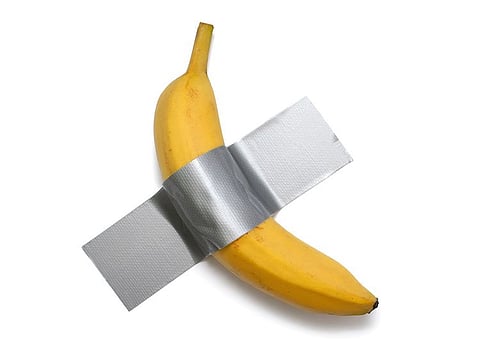The Duct-taped banana artwork is coming to auction asking $1 million
Buyer receive a certificate of authenticity that confers right to manifest the artwork

It was the banana seen round the world.
When the artist Maurizio Cattelan duct taped a fresh banana to a wall at Art Basel Miami Beach in 2019 it caused an immediate uproar. Cattelan’s gallery was soon forced to take the piece down because crowds in the booth became unmanageable; within days it was the subject of memes and knockoffs. Celebrities posted about it; Serious Art Critics weighed in; one person ate it. And perhaps most important, collectors snapped it up.
The work, which is titled Comedian, was produced in an edition of three, with reported prices of $120,000 to $150,000 apiece; one piece was donated to the Guggenheim Museum; the other two are owned privately.
Five years later, one of the works in private hands will be offered to the public with a notably higher price tag: Its presale estimate is $1 million to $1.5 million. “We’re handling not only one of the most important and significant works of art [Cattelan] has ever made,” says David Galperin, head of contemporary art for the Americas at Sotheby’s, “it’s really one of the most talked about works of the century. So is the value of $1 million to $1.5 million scientific? No. But could it go far beyond that? I believe so.”
Understanding value
In art, value has never been derived from materials alone. A painting by Picasso is just pigment on canvas; for that matter, Michelangelo’s David is just a chunk of stone. And over a century ago Marcel Duchamp’s Fountain, a urinal he turned on its side, effectively did away with (among other things), the question of whether or not an artist’s “hand” was necessary for an object to become an artwork. Today, the art world is saturated with artworks, conceptual or otherwise, made from readymade materials. In that respect Comedian is nothing new.
What is arguably more novel about the work, however, is that it’s been interpreted as commentary on the absurdity of the art market itself. Allowing the public to bid on it, Galperin says, will be a fitting next chapter for its time in the public eye.
“This is a work of art that has provoked so much debate and dialogue around this notion of value specifically with respect to art,” he explains. “There’s no better platform to engage in that discussion than public auction.”
What You’ll Get
Whoever buys the work will receive a certificate of authenticity. That certificate confers the right to manifest the artwork, and also includes detailed display instructions. As an added bonus, the winning bidder will receive a roll of duct tape and a banana, which at the very least will save them an initial trip to their local supermarket.
“The banana and duct tape can be replaced as needed,” Galperin notes. “It’s not an original duct tape and banana.” (This edition has already sold privately once before.)
The inclusion of the work in Sotheby’s all-important contemporary Nov. 20 evening sale has been a closely kept secret, Galperin says. “Not a single soul knows about it aside from one or two members of my team, and the journalists we reached out to in the last 24 hours.”
As such, they’ve done absolutely no advance marketing or outreach, but Galperin says he’s confident there will be an outpouring of interest as the piece embarks on a world tour to New York, London, Paris, Milan, Hong Kong, Dubai, Taipei, Tokyo and Los Angeles in advance of the sale.
There will be traditional art collectors vying for the work for whom Galperin says the duct-taped banana would be “a significant trophy,” but its global fame, he continues, means that the audience could be much larger.
“Given the way in which this work of art was able to puncture through the confines of the art world and enter the public, pop cultural consciousness,” he concludes, “this has the potential to generate interest from truly everybody.”
Sign up for the Daily Briefing
Get the latest news and updates straight to your inbox



